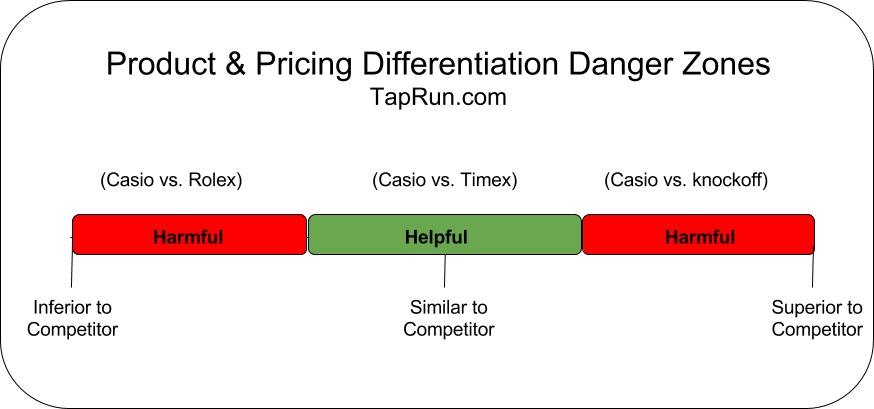The Differentiation Danger Zones
Tuesday, March 15, 2016
I've heard a number of know-it-alls talk about the importance of differentiation. They say that when you differentiate your product, you can charge more. In many cases, this is absolutely true. If customers think that you're different than the competition, you open their minds to the possibility that your offerings might be worth more than the competition's.
Today we'll look at one reason why differentiation doesn't always work.
Before I get into the details, try to answer the following questions:
- Does Nike differentiate its sneakers from Sam Adams' Beer?
- Does Pepsi differentiate its sodas from Boeing's jets?
- Does Microsoft differentiate its software from Trek's bicycles?
The answer to all three questions is an emphatic "No." A company would rarely benefit from differentiating its products from completely dissimilar items. People do not need to be told that a pair of sneakers is different than a bottle of beer. They already know it.
The only reason to differentiate your products from those of another firm is to widen the gap in a potential consumer's mind.
Now here's the confusing part:
Sometimes the act of differentiating two items can make them seem more similar. Let's look at two watch companies: Casio and Rolex.
I'll preface this by saying that I own a Casio watch. I purchased it for $9.71, and it was worth every penny. In my mind, Casio's offering are far superior. They are lighter, smaller, more accurate, easier to read in the dark, have greater functionality and are cheaper to boot.
Nevertheless, if Casio began to explicitly differentiate itself from Rolex, very few potential Rolex buyers would be swayed to a Casio. The people who buy Rolex watches aren't interested in the characteristics for which Casio is the clear winner. If anything, it would only accentuate the characteristics for which Casio is considered the lesser choice. It would be like a flyweight boxer comparing himself to a heavyweight - a recipe for disaster.
Now let's say that Casio decided to differentiate its products from that of a more similar competitor. If Casio could clearly differentiate itself from Timex, it might gain market share while increasing its prices. Buyers would no longer decide between a Casio or a Timex; they'd go straight for the Casio. After all, who wouldn't be willing to pay a little more for a better product?
Now imagine that Casio started differentiating itself from some really low quality watches - the type you'd find on street corners. Casio might launch a bold advertising campaign: "More comfortable than low-quality knockoffs." What do you think would happen?
On first blush, you might think that Casio would improve its standing. After all, it's differentiating itself from an inferior product. That might be the case, but something else might happen too. People might see that Casio is actually comparing itself to lower quality goods and make the assumption that the two types of watches are in the same category. After all, if Casio is going to great lengths to differentiate its products from cheap knockoffs, and everyone knows that it only makes sense to differentiate products in the same category, then Casio's watches must be similar to knockoffs. Hoisted by its own petard!

The lesson? Differentiate with care! When you differentiate, you acknowledge that there are similarities. If your audience doesn't already believe that those similarities exist, your advertising might do more harm than good.
Casio didn't pay me for my advice, but you could! Contact me for a pricing consultation.